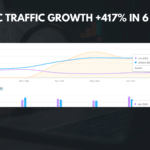
|
Getting your Trinity Audio player ready... |
Social media has become an integral part of our daily lives, and it has also revolutionized the way businesses market their products and services. With billions of people using social media platforms like Facebook, Instagram, Twitter, and LinkedIn, it has become a goldmine for marketers to reach and engage with their target audience. In this blog post, we will explore the importance of social media in marketing and provide valuable tips and strategies to optimize your social media profiles, create eye-catching visual content, craft compelling social media posts, grow your social media following, harness the power of user-generated content, build a strong community, measure social media success through analytics, stay ahead of emerging trends, and create an effective social media strategy.
Key Takeaways
- Social signals are important for SEO and brand awareness
- Optimize your social media profiles with consistent branding and engaging content
- Use eye-catching visuals to grab attention and convey your message
- Craft compelling posts with a clear call-to-action and audience targeting
- Grow your following with hashtags, influencer marketing, and user-generated content
- Foster a strong community by engaging with your audience and providing value
- Measure success with analytics and track key metrics like engagement and reach
- Stay ahead of trends by keeping up with emerging technologies and platforms
- Create an effective strategy by setting goals, defining your audience, and planning content and campaigns.
Understanding the Importance of Social Signals
Social signals refer to the likes, shares, comments, and overall engagement that a piece of content receives on social media platforms. These signals are important because they indicate to search engines like Google that a piece of content is valuable and relevant. As a result, search engines may rank that content higher in search results. In other words, social signals can have a direct impact on your website’s search engine optimization (SEO) efforts.
For example, if you have a blog post that receives a high number of shares on Facebook or Twitter, it sends a signal to search engines that people find the content valuable and worth sharing. This can lead to higher rankings in search results and increased organic traffic to your website.
How to Optimize Your Social Media Profiles for Maximum Engagement
Having a complete and consistent profile across all your social media platforms is crucial for maximizing engagement with your audience. Your profile picture should be professional and recognizable, such as your company logo or a high-quality headshot if you are a personal brand. Your bio or description should clearly communicate who you are or what your business does in a concise and compelling way. It should also include relevant keywords to improve searchability.
When choosing usernames and handles, it’s best to keep them consistent across all platforms to make it easier for your audience to find and connect with you. Avoid using numbers or special characters that can make your username difficult to remember or type. Instead, opt for a username that reflects your brand or business name.
The Power of Visual Content: Tips for Creating Eye-Catching Images and Videos
| Metrics | Values |
|---|---|
| Number of social media shares | 10,000 |
| Number of website visits | 50,000 |
| Engagement rate on social media | 15% |
| Number of leads generated | 500 |
| Conversion rate | 10% |
| Time spent on website | 2 minutes |
| Bounce rate | 30% |
Visual content is a powerful tool in social media marketing because it captures attention and conveys messages quickly and effectively. Whether it’s images, videos, infographics, or GIFs, visual content can help you stand out from the crowd and engage your audience.
When creating visual content, it’s important to focus on quality. Use high-resolution images and videos that are clear and visually appealing. Pay attention to composition, lighting, and colors to create visually striking content. If you don’t have the resources or skills to create your own visual content, there are plenty of free or affordable stock photo and video websites where you can find high-quality visuals for your social media posts.
Different social media platforms have different requirements and best practices for using visual content. For example, Instagram is a highly visual platform where users expect high-quality images and videos. On the other hand, Twitter has a character limit, so it’s important to choose visuals that are concise and impactful.
Crafting Compelling Social Media Posts: Best Practices for Captivating Your Audience
Crafting well-written social media posts is essential for capturing the attention of your audience and encouraging engagement. One of the most important elements of a social media post is the headline or caption. It should be concise, attention-grabbing, and relevant to the content you are sharing. Use strong verbs, ask questions, or make bold statements to pique curiosity and encourage clicks.
Emojis can also be used to add personality and emotion to your social media posts. They can help convey tone and make your posts more relatable and engaging. However, use emojis sparingly and make sure they are relevant to the content you are sharing.
Hashtags are another important element of social media posts. They help categorize and organize content, making it easier for users to discover your posts. Research popular hashtags in your industry or niche and use them strategically in your posts. However, avoid using too many hashtags as it can make your posts look spammy.
Calls-to-action (CTAs) are crucial for encouraging engagement and driving desired actions from your audience. Whether it’s asking them to like, share, comment, or click a link, make sure your CTAs are clear, concise, and compelling. Experiment with different CTAs to see what works best for your audience.
Strategies for Growing Your Social Media Following: From Hashtags to Influencer Marketing
Having a large and engaged social media following is important because it increases the reach and visibility of your content. One strategy for growing your social media following is by using hashtags strategically. Research popular hashtags in your industry or niche and use them in your posts to increase visibility and reach a wider audience. You can also create branded hashtags that are unique to your business or campaign to encourage user-generated content and increase brand awareness.
Influencer marketing is another effective strategy for growing your social media following. Collaborating with influencers who have a large and engaged following can help you reach a wider audience and build credibility. Look for influencers who align with your brand values and target audience, and reach out to them for collaboration opportunities such as sponsored posts or partnerships.
Harnessing the Power of User-Generated Content to Boost Engagement and Reach
User-generated content refers to any form of content that is created by your audience or customers. It can be in the form of reviews, testimonials, photos, videos, or social media posts that mention or tag your brand. User-generated content is powerful because it provides social proof and builds trust with your audience.
To encourage user-generated content, you can run contests or giveaways where participants are required to create and share content related to your brand. You can also ask for reviews or testimonials from satisfied customers and share them on your social media platforms. Make sure to give credit to the creators of user-generated content and engage with them by liking, commenting, or sharing their posts.
Building a Strong Community on Social Media: Tips for Fostering Meaningful Connections
Building a community on social media is important because it helps foster meaningful connections with your audience and builds loyalty. One of the best ways to build a community is by engaging with your followers. Respond to comments, messages, and mentions in a timely manner and show genuine interest in what they have to say. This not only helps build relationships but also encourages others to engage with your content.
Another tip for building a strong community is by creating opportunities for interaction and conversation. Ask questions, run polls or surveys, and encourage your audience to share their thoughts and opinions. This not only helps you understand your audience better but also makes them feel valued and heard.
When responding to comments or messages, it’s important to be professional, polite, and helpful. Even if you receive negative feedback or criticism, respond in a constructive manner and try to resolve any issues or concerns. This shows that you care about your audience’s feedback and are committed to providing excellent customer service.
The Role of Analytics in Measuring Social Media Success: Key Metrics to Track
Tracking social media metrics is important because it helps you measure the success of your social media efforts and make data-driven decisions. Some key metrics to track include engagement, reach, conversions, and follower growth.
Engagement metrics include likes, comments, shares, and clicks on your social media posts. They indicate how well your content is resonating with your audience and how engaged they are with your brand. Reach metrics measure the number of people who have seen your content. This can help you understand the effectiveness of your social media strategy in reaching your target audience.
Conversions metrics track the number of desired actions taken by your audience, such as signing up for a newsletter, making a purchase, or filling out a contact form. This helps you measure the ROI of your social media efforts and identify areas for improvement.
Follower growth metrics measure the number of new followers gained over a specific period of time. This can help you understand the effectiveness of your growth strategies and identify opportunities for increasing your social media following.
Tips for Staying Ahead of the Curve: Emerging Trends in Social Media Marketing
Social media marketing is constantly evolving, and it’s important to stay ahead of the curve to remain competitive. One emerging trend in social media marketing is live video. Platforms like Facebook, Instagram, and YouTube offer live streaming capabilities that allow you to connect with your audience in real-time. Live video is a great way to engage with your audience, showcase behind-the-scenes content, host Q&A sessions, or launch new products or services.
Another emerging trend is the use of chatbots. Chatbots are AI-powered tools that can automate customer interactions and provide instant responses to common queries. They can be used on platforms like Facebook Messenger to provide customer support, answer frequently asked questions, or even facilitate sales transactions.
To stay up-to-date with the latest trends in social media marketing, it’s important to follow industry blogs, attend webinars or conferences, and network with other professionals in the field. Experiment with new features and functionalities offered by social media platforms to see what works best for your brand.
Creating an Effective Social Media Strategy: Best Practices for Planning and Execution
Having a well-planned social media strategy is crucial for achieving your marketing goals and maximizing the effectiveness of your social media efforts. Start by setting clear and measurable goals that align with your overall business objectives. Whether it’s increasing brand awareness, driving website traffic, generating leads, or boosting sales, make sure your goals are specific, achievable, and time-bound.
Next, define your target audience. Understand their demographics, interests, pain points, and online behavior. This will help you create content that resonates with your audience and drives engagement.
Create a content calendar to plan and organize your social media posts. This will help you maintain a consistent posting schedule and ensure that your content is diverse and relevant. Use a mix of promotional, educational, entertaining, and inspirational content to keep your audience engaged.
Finally, measure the success of your social media strategy using the metrics discussed earlier. Analyze the data to identify what’s working and what’s not, and make adjustments accordingly. Continuously monitor industry trends and consumer behavior to stay ahead of the curve and adapt your strategy as needed.
Social media has become an essential tool for businesses to reach and engage with their target audience. By optimizing your social media profiles, creating eye-catching visual content, crafting compelling social media posts, growing your social media following, harnessing the power of user-generated content, building a strong community, measuring social media success through analytics, staying ahead of emerging trends, and creating an effective social media strategy, you can maximize the impact of your social media marketing efforts. Implement the tips and strategies discussed in this blog post to take your social media marketing to the next level and achieve your business goals.
If you’re interested in learning more about social signals and their impact on digital marketing, check out this informative article on unlocking digital excellence with Chandigarh’s white-label social media solutions. This article dives deep into the strategies and techniques used by social media experts to boost online presence and drive engagement. Discover how choosing the right SEO company in India can maximize your online presence and learn about the power of SEO optimization in this comprehensive guide.
FAQs
What are social signals?
Social signals refer to the likes, shares, comments, and other interactions that people have with content on social media platforms. These interactions can indicate the popularity and relevance of the content to the audience.
Why are social signals important?
Social signals are important because they can influence search engine rankings and visibility. Search engines like Google consider social signals as a factor in determining the relevance and authority of a website or content.
How do social signals affect SEO?
Social signals can affect SEO by increasing the visibility and traffic of a website. When content receives a lot of social signals, it can attract more backlinks and improve its search engine rankings.
What are some examples of social signals?
Examples of social signals include likes, shares, comments, retweets, pins, and upvotes. These interactions can occur on social media platforms like Facebook, Twitter, Instagram, Pinterest, and Reddit.
How can businesses use social signals?
Businesses can use social signals to improve their online presence and reputation. By creating engaging content that encourages social interactions, businesses can attract more followers and customers. They can also monitor social signals to understand their audience and improve their marketing strategies.
What are some best practices for using social signals?
Some best practices for using social signals include creating high-quality content that is relevant and engaging to the audience, encouraging social interactions through calls-to-action, monitoring social signals to understand audience behavior, and engaging with followers to build relationships and loyalty.























































